Abstract
The article deals with examples of the fine monumental art of Krasnoyarsk in the period from early industrialization to the present. The analysis of the dynamics of changes in plots in the historical perspective is carried out. The main techniques and methods for the formation of such objects are considered, such as: fresco, mosaic, sgraffito and stained glass. The influence of such art on the formation of "Third Places" is revealed, according to the concept of Roy Oldenburg. The sociocultural and economic significance of such art objects for the formation of a sustainable culture of everyday life, increasing the motivation of employees and improving the overall level of well-being for city residents has been proven. Given the wide distribution of such objects throughout the post-Soviet territory, such a study can be easily replicated and carried out in any other region, based on the materials proposed in this article. The paper can be useful in the study of economics, cultural studies, psychology, art history, religious studies, and design.
Keywords: Industrialization, monumental art, street art
Introduction
Traditionally, the period of the first three five-year plans is called the main period of industrialization of the Soviet Union. The process, begun in 1928, led to the fact that by 1940 over 8,500 large enterprises had been built. Metallurgy, heavy engineering, medicine and construction were actively developing. And although the Third Five-Year Plan was interrupted by the Great Patriotic War, the growth rates are truly impressive (Belkin et al., 2018). By the way, we add that the processes of industrialization of already existing cities and the active construction of new ones continued after the war. Thus, it can be said that, thanks to a directed industrialization policy, the Soviet Union turned from a de facto agrarian state into an industrial giant with a well-organized industry.
This fully responded to the triune task of radical transformation of society, which included industrialization, the collectivization of agriculture and the cultural revolution (Sokolov, 1999). In fact, this process is the second wave of the scientific and technological revolution (Toffler, 2004), which inevitably leads to a radical restructuring in society. Industrialization affected such processes as:
- Changing the education system.
- Large-scale electrification.
- Transformation of urban space.
- Creation of new planned single-industry towns.
- Creation of a unified infrastructure.
- Large-scale migration of residents to new cities and districts.
Of course, this is not a complete list, but these are the most significant factors that accompanied the policy of industrialization. New factories and factories required qualified personnel. Beginning in 1930, compulsory universal seven-year education was introduced, and then compulsory ten classes appear (1932). At the same time, institutions of higher professional education are also actively developing. Thus, by 1937, the number of higher education institutions increased 7.7 times compared to 1914 (Belkin et al., 2018). No less significant are all-Union construction projects and significant internal migration, which did not always take place voluntarily, but gave a generally positive result (Gozulov & Grigor'janc, 1969). Thus, for example, due to internal migration of workers, the Ural s, Siberia and the Far East received 3,257,000 people by 1939 (Maksudov, 1999).
However, industrialization also posed new challenges for the country's leadership. Huge leaps in scientific and technological development, education, resettlement to new places and the rejection of religious thinking (Decree of the Council of People's Commissars, 1918) demanded both a new vector of development and new platforms for uniting the masses.
Therefore, the main factor in the success of industrialization was:
Methods of inspiring the people, raising enthusiasm, purposeful involvement in the process of industrial development. By means of literature and art, images of a bright future were formed, examples of proper behaviour, and examples were given of what hinders the construction of socialism (Belkin et al., 2018, p. 1328).
Literature, cinema and the fine arts were the first to respond to the calls of the new ideology. Then there were architects and muralists. From this moment on, the triune task of radically reorganizing society begins to work as a single mechanism.
In the post-war period, Academician Zhukovsky proposed his own comprehensive approach to solving this issue. In his article "City, street, house" Zhukovsky sets the vector for the formation of the Soviet city for the next 20-25 years. At the same time, he sees the creation of a single idea for the city as the key task of the architect, otherwise “even the most beautiful buildings are dead if they are not connected by the idea of a single city” (Zhukovsky, 1951, p. 2). At the same time, in addition to the basic design issues (supplying electricity, water supply systems, sewerage, etc.), the following issues are mandatory for resolution:
- cultural and community services (theaters, clubs, stadiums, baths, laundries, etc.);
- use and enhance the natural beauty of the natural landscape by forming an outstanding architectural structure and organizing a city center and a place of recreation for the population around it;
- color range. Since “the socialist city should be decided in a bright, joyful scale. It should, with the help of color, create the impression of sunshine even in autumn and winter.
This idea ends with the thesis that “In a bright and beautiful city, people work more cheerfully and live more comfortably” (Zhukovsky, 1951, p. 2). Thus, we can talk about the beginning of the formation of a new integrated approach not only to urban planning and architecture, but also to monumental industrial art as such. This approach, no doubt, should have strengthened the position of the then popular Stalinist Empire with its eclectic architecture and richness of decorative elements.
However, this did not happen. On the contrary, on November 4, 1955, the Central Committee of the CPSU and the Council of Ministers of the USSR adopted Resolution No. 1871 "On the elimination of excesses in design and construction." Speaking quite simply, the essence of the document boils down to a simple scheme: fast, cheap, standard construction is good, and individual projects with expensive decorative elements are bad and unacceptable. The text said that Soviet architecture should be characterized by simplicity, rigor of forms and cost-effectiveness of solutions (StrelkaMag, 2020).
However, it was this document that had a direct impact on the further development and formation of monumental industrial fine art in the formation of third places.
Problem Statement
Taking into account the active struggle against “extra” elements in architecture and the general simplification of construction forms, it is necessary to find out the reasons why monumental industrial art turned out to be so widespread throughout the territory of the former Soviet Union and what functions it (art) performed.
Research Questions
Identification of socio-economic factors of the popularization of monumental industrial art in the USSR.
Purpose of the Study
Please replace this text with context of your paper. Conducting an analysis of surviving examples of monumental industrial art (on the example of Krasnoyarsk):
- Their typology and artistic analysis;
- Identification of socio-economic factors of occurrence;
- Proof of the significance of these art samples for the formation of "Third Places" according to R. Oldenburg.
Research Methods
In order to understand the significance of monumental industrial art for third places in the designated period, we will use the following methods:
- Comparative analysis,
- Theoretical review of the literature,
- In-depth interview method.
First of all, it is necessary to reveal the concepts of monumental industrial art and "third place".
According to the short dictionary on aesthetics (The brief esthetics vocabulary, 2021), monumental art is understood as a kind of fine art that embodies great social ideas, designed for mass perception and existing in synthesis with architecture, in an architectural ensemble where the key is not only artistic design and synthesis with architecture, but also monumentalizing (from the Latin monumentum - monument) of an event, phenomenon or an entire era.
At the same time, it is important to note that when forming new single-industry towns (built around a city-forming enterprise) and designing new districts in already built settlements, a certain general synthesis of architecture and monumental and decorative art was taken into account even at the plan level. This symbiosis can be clearly seen in the works of Soviet modernism (Solodilov & Korobova, 2017).
This symbiosis had several tasks:
First of all, it was necessary to form a general aesthetic perception. This became especially important after the approval of the houses of the planned panel building K-7 according to the projects of the architect Lagutenko (popularly nicknamed "Khrushchevki"). And although this housing construction fully met the requirements of the XX Congress of the CPSU in 1956, in which N.S. Khrushchev set the overarching goal of ending the housing shortage over the next 20 years, which had some drawbacks. Namely, the grey monotony of buildings, devoid of individuality, could negatively affect citizens, having a depressing effect (Solodilov & Korobova, 2017).
Secondly, it was experimentally established that the facades of buildings decorated with frescoes, sgraffito or mosaic panels did not require additional repairs for a long time, since the smalt from which the work was carried out is a very durable and wear-resistant material that did not need any repairs, not even in the sink, since natural precipitation coped with the latter task. At the same time, buildings decorated with mosaics, frescoes or sgraffito received additional insulation, because. layers of plaster for frescoes or sgraffito were applied with high quality and sufficiently thick salts.
And typical courtyards, decorated in this way, began to take on the functions of a “third place” along with all others.
The term "third place" belongs to the sociologist Ray Oldenburg. He describes his concept in the book of the same name:
... daily life, in order to be enjoyable and fulfilling, must balance the three realms of experience. One is the home, the second is profit making or production, and the third is the realm of inclusive communication, which is both the foundation of community building and its best outcome (Oldenburg, 2014, p. 456).
In fact, this means that a resident of a modern city has three main places of his pastime. The first is the house. A place that can be defined as his personal space, hidden from the rest and accessible only to the closest. It is in this first place that the basic social roles of father, mother and others are realized.
According to Oldenburg, the second place is the workplace. Place of implementation of professional skills, competencies and roles. Place of earnings, achievement of personal and social benefits, implementation of tasks set by management and professional growth.
The third place, according to this concept, is a place different from the first two and meeting some functional requirements and characteristics.
The main function of the third place is the unification of the district into a single whole. This happens due to certain mechanisms of interaction between people.
The third place can be compared to a mixer where the process of assimilation takes place. Such a place can be considered a port of arrival for visitors and a place where newcomers can be introduced to many of those who have long lived here.
At the same time, it is also a neutral territory (a space where a person is not burdened by the role of a host or a guest). It offers the delightful ease of communication that is so important to the life of the community.
It is also a sorting hub where the large-scale communication that such a place provides eventually leads to elements of sociometry. That is, people eventually discover that they like some people and dislike others. They find people with similar interests, as well as those whose addictions are not similar to their own, but are still interesting. Third places often serve to bring people together for the first time.
Related to this is the function of the third place as an organizational point. A place of mass meetings, solutions to common issues, mutual assistance and assistance. Third places also provide for what are commonly referred to as public figures. These are people who know everyone in the area and care about their area.
Among the noblest of the functions of the third place, which Oldenburg (2014) singles out in his book is the joint relaxed and pleasant recreation of young people and adults. Thus, this place is equally well suited to representatives of all generations.
Oldenburg characterizes the third place as inconspicuous, accessible and, in a certain sense, neutral. The combination of these characteristics inevitably leads to the appearance of regular visitors (regulars), who can fully satisfy their needs for a variety of communication, conversation and games. As a rule, this forms a fairly peaceful atmosphere that can win over people of different social status and age. In this regard, we can talk about the third place as a space where gender, social and professional roles do not play a special role.
In the book The Third Place, the author talks about America at the turn of the 80s and 90s, giving the following examples of third places and their development: from a classic tavern to a cozy cafe and bar, the main street (avenue) of the city, the city garden. Today you can add sports centers, parks and squares, baths and saunas, gambling houses, restaurants and shops. In Soviet reality, there were many of the above. But separately, a large Soviet courtyard can be added to this list of places, which quite fits the definition of home away from home and ennobling natural environment (Oldenburg, 2014).
As a result, such a space takes on some auxiliary functions for organizing the processes of everyday life. The openness of the third place can be interpreted as a certain political aspect. The possibility of open meetings encourages conversation and interaction and thus forms the habit of communication. And this, in turn, leads to the openness of the society itself, the simplicity of social control in itself, without attracting additional funds and resources. This happens due to unity and the formation of stable relationships in the planes: man - man and man - society. Definitely, third place is the power of good. It provides its regulars with the opportunity for more dignified human relationships than those that prevail outside, and the regulars are accustomed to using this opportunity (Oldenburg, 2014).
All these processes were confirmed by the researchers in a series of in-depth interviews.
Findings
Based on the foregoing, the following conclusions can be drawn:
Although the decree "On the elimination of excesses in design and construction" significantly simplified and reduced the cost of production, planning and the general appearance of the architectural ensemble, it retained the general vector of development proposed by academician Zhukovsky.
Being a direct consequence of the policy of industrialization, the new architecture, in synthesis with monumental art, in a relatively short time was able to give urban residents all the three places at once. City-forming enterprises provided people with jobs, micro districts under construction provided housing, and developing infrastructure and courtyards created third places, often decorated with works of monumental industrial art.
In his book The Art of Loving, Erich Fromm (2014) notes the importance of a person's feeling of unity with someone or something. Otherwise, if this unity does not occur, a person involuntarily falls into anxiety and, as a result, embarks on the path of conformism. This can be especially acute for people with working specialties, whose daily work becomes a routine. Fromm emphasizes the importance of interpersonal fusion.
According to Fromm (2014):
In the modern labor process of a clerk or worker at an endless conveyor belt, little remains of the unifying quality of work. The worker becomes an appendage of a machine or a bureaucratic mechanism. He ceases to be himself; therefore, no unity, apart from conformism, arises. (p. 224)
Such self-identification could arise due to two key factors: the general context and the nature of the third places, that is, the semantic content created by the images created by muralists.
The most common themes in artistic and decorative monumental art were:
- Scenes from everyday life. Both in the work process and in the family and household;
- Portrait images of cult personalities;
- Achieving excellence or processes to achieve it;
- Historical scenes and personalities;
- Certain references to memorable events and dates.
All these themes can also be found in traditional icon painting. Where the Gospel stories, stories from the life of ascetics and saints, the most significant and memorable events are also illustrated.
Indirectly, these relationships can be traced in the fact that the flourishing of monumental art falls on the period of the anti-religious campaign of N.S. Khrushchev 1958-1964 and the fact that the techniques in which muralists worked are similar to those of the church (Pivovarov, 2021).
Let's consider some of them:
1) Mosaic. Although the beginning of the Soviet mosaic can be traced back to 1925, when two coats of arms of the Soviet Union by the artist V. A. Frolov appeared on the building of the Kievsky railway station in Moscow, its widespread distribution occurs at a later period. Monumental artists worked with smalt, the colour of which was formed under the action of metal oxide or coloured ceramics.
Durability, scale and beauty allow us today to see both the first mosaics of early Christians and the works of Soviet artists. For example, in Krasnoyarsk you can see some excellent works by the muralist A.S. Lapko, who made the “Flight” panel for Aeroflot (Figure 1) or Yuri Funkorineo, who created the large-scale composition “Biolife” for the drug factory (Figure 2).
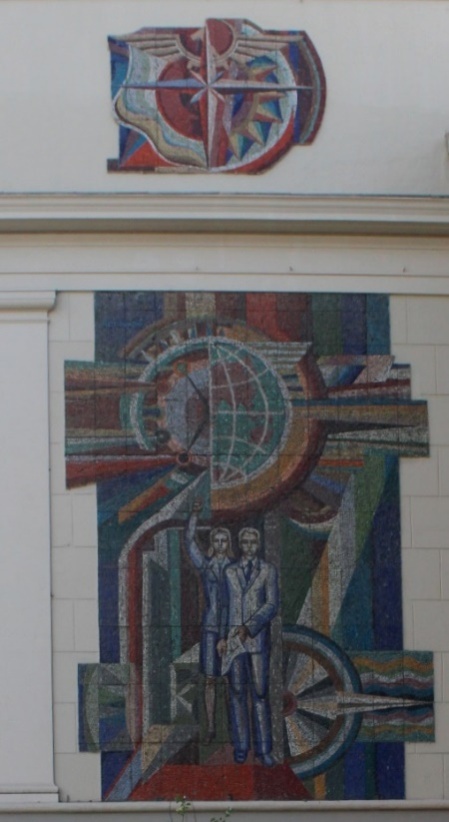
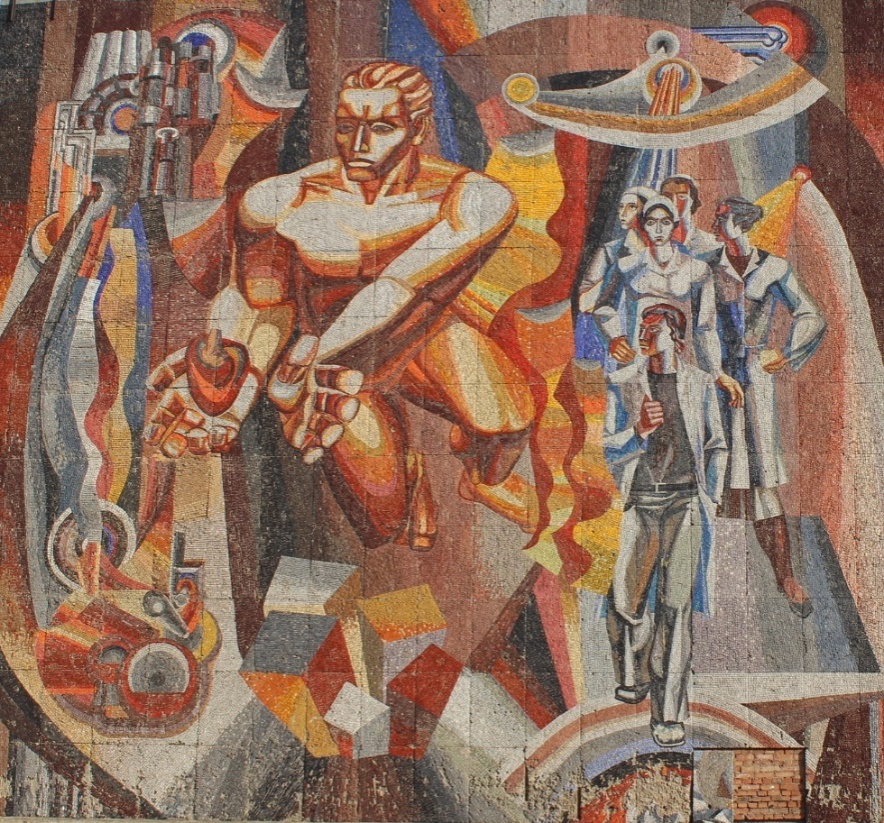
But there is also something that the Krasnoyarsk muralists brought to the technique of execution. So, for example, the most recognizable mosaic panel "Motherland" on the facade of the cinema "Rodina" (the House of Friendship of Peoples after the restoration of the building) on Krasnoyarsky Rabochiy Avenue is made not from smalt, but from Yenisei pebbles. The author of this panel (Figure 3) Evgeny Kobytev (Figure 4). The plot of this work is no less interesting: the mother raises the child, showing him his homeland. And since the action takes place against the backdrop of Pillars, we can assume that she is showing her child exactly Krasnoyarsk.
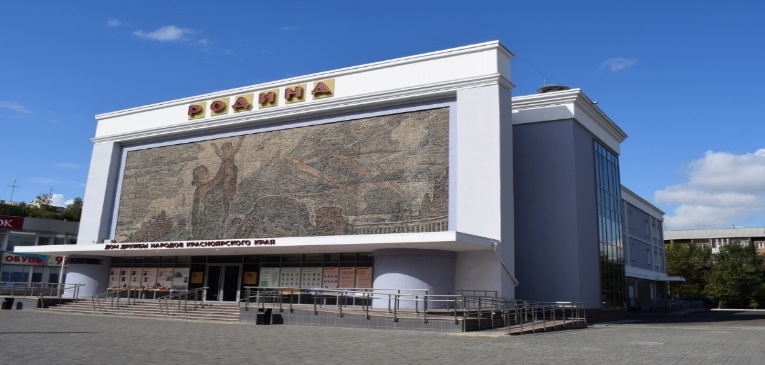
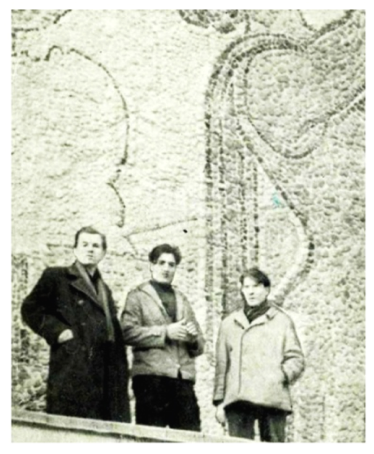
2) Fresco. Fresco is more common than mosaic. In Krasnoyarsk, for example, you can see original frescoes from 1951 (Figure 5) that adorn the ceilings of the river station. The theme of these frescoes are the sights of the city: natural and urban motifs. Or later frescoes on the facades of five-story buildings, for example, on the right bank of Krasnoyarsk (Figure 6).
These two examples clearly show the transformation of the general stylistics, themes and techniques of the implementation of the monumental fresco in the Soviet period under the influence of the decree On the Elimination of Excesses in Design and Construction. In addition to the fact that most of the decorative elements disappeared and the fresco moved from the ceilings to the outer walls, the theme and message of the work itself changed. The greatest attention is now paid to scenes from everyday life, which glorify the feat of the worker. It is important to note that in later frescoes, a person is never depicted alone. He is always among colleagues, family members or other members of society. In this case (Figure 6) these are scenes from the daily life of a shipyard.
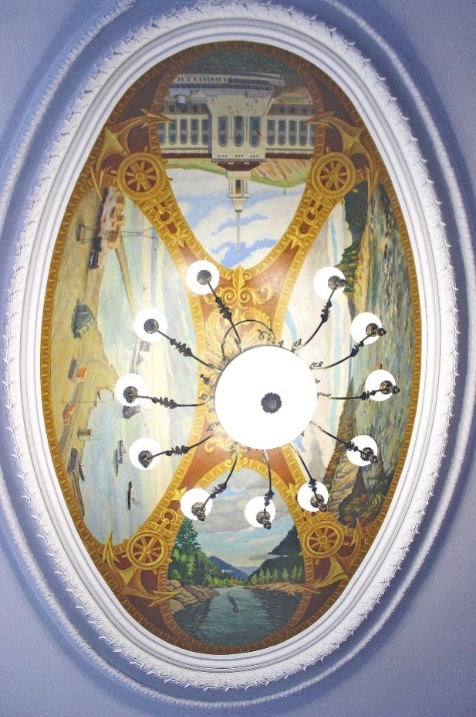
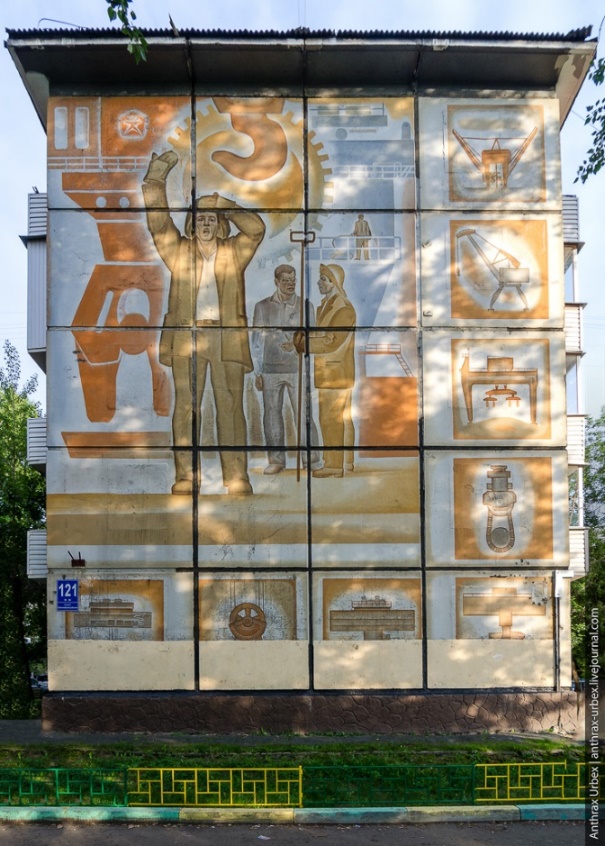
3) Stained glass windows. Made in the classical technique of colored glass with lead bridges in Krasnoyarsk are quite rare. They can be seen in the Organ Hall. However, given the fact that the organ hall is located in the building of a former Catholic church, such a decision seems quite logical and justified. When creating stained-glass windows for the organ hall, only their subject matter was changed. So, the figures of the apostles were replaced by the figures of musicians and composers (Figure 7). At the same time, the general atmosphere has not actually changed.
Much more interesting are the stained-glass windows located in the house of science and technology. Made in the classical technique, they are a vivid example of Soviet modernism of the late 70s. The theme is quite consistent with the location: space, science, the future (Figure 8).
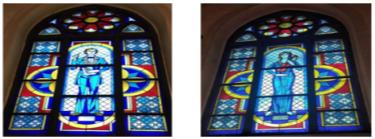
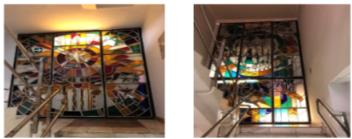
Comparing these three techniques of monumental fine art with classical church works, we can conclude that Soviet muralists kept in touch with the classical school and primary sources, but in no case copied them, but developed and brought something new, consistent with the spirit time. And although the works of monumentalists differed from the previously existing church works, in general they met the same goals and served as a kind of spiritual and moral guidelines.
Thus, we can conclude that monumental art not only decorated the facades of buildings, served as insulation or a facing layer, but also served as “watchtowers of public space” (Oldenburg, 2014).
Conclusion
Please replace this text with context of your paper. Thanks to the policy of industrialization and the typical development of single-industry towns and new microdistricts, it was possible to provide a sufficiently large number of people with all the places necessary for everyday life: the first (home), the second (workplace) and the third (neutral space). However, in the case of Soviet reality, the third place did not exist on its own, but was some kind of harmonious symbiosis of the first two. A special space in this respect can be considered a large courtyard, usually formed by three or four five-story buildings. Thanks to the commonality, similarity of thinking, value orientations and separation from religious consciousness, the third place in the USSR took on some features of templeism (Pivovarov, 2021). Largely due to industrial monumental art, which referred to labour and military exploits, scenes of a happy family life and the importance of the team in the life of a Soviet person. It is characteristic that in monumental art it is very rare to find single portraits. An exception, perhaps, can be considered the images of Yu. A. Gagarin. This indicates a great attention to the issues of everyday life of city residents, their work processes and the organization of leisure and life. The importance of collective work, team cohesion is thus elevated to the absolute, which, in turn, guarantees high economic, social and cultural indicators.
Acknowledgments
The article was written as part of the project “Monumental Art of Krasnoyarsk. Forgetting cannot be saved” with the support of the Presidential Fund for Cultural Initiatives. Application No. PFKI-22-1-008355.
References
Belkin, V. N., Belkina, N. A., & Antonova, O. A. (2018). Innovative Activity of Business Managers as a Condition for Modernization of Regional Labour Potential. Economy of Region, 14(4), 1327-1340. DOI:
Decree of the Council of People's Commissars. (1918). "On the separation of church from state and school from church. Retrieved on July 12, 2021 from https://constitution.garant.ru/history/act1600-1918/5325/
Fromm, E. (2014). The art of love (AST).
Gozulov, A. I., & Grigor'janc, M. G. (1969). National population of the USSR (Moscow).
Kraskompas. (2021). Mosaic "Motherland" on the facade of the cinema «Rodina». Retrieved on July 23, 2021 from https://www.kraskompas.ru/nash-gorod/zhenskie-obrazy-goroda/item/1335-mozaika-rodina-mat-1965-g.html
Maksudov, S. (1999). Migrations in the USSR in 1926-1939. Cahiers du Monde Russe, 40(4), 763-796. DOI:
Oldenburg, R. (2014). The third place: cafes, coffe houses, bookshops, bars, beauty salons and other places for hangouts as the fundament of the society (New literary review).
Pivovarov, G. O. (2021). Industrial fine arts. Industry and "Third Places" (on the example of Krasnoyarsk). Siberian Anthropological Journal, 3(9), 366-376. DOI:
Prospekt m. (2019). The fading nature: 16 Soviet mosaics in Krasnoyarsk which worth seeing. Retrieved on July 23, 2021 from https://prmira.ru/article/sovmod/
Sokolov, A. K. (1999). Course of Soviet history, 1917-1940 (Moscow: High School).
Solodilov, M. V., & Korobova, E. S. (2017). Synthesis of architecture and monumental and decorative art in the architecture of the Soviet modernism on the example of Tolyatti. City building and architecture, 7(3), 17-123. DOI:
Strelkamag. (2020). The document that has changed everything. The most important things about the decree “About elimination of extras”. Retrieved on July 20, 2021 from https://strelkamag.com/ru/article/dokument-kotoryi-izmenil-vsyo
The brief esthetics vocabulary. (2021). Retrieved on July 20, 2021 from https://esthetiks.ru/monumentalnoe-iskusstvo.html
The history of architecture. (2021). Retrieved on July 23, 2021 from http://naov.ru/objects/photos/intereri-rechnogo-vokzala-ul-dubrovinskogo-1-g-krasnoyarsk.html
Toffler, E. (2004). The third wave. (ACT).
Zhukovsky, I. V. (1951). Town, street, house. Technics of the youngsters, 1, 2-4.
Copyright information

This work is licensed under a Creative Commons Attribution-NonCommercial-NoDerivatives 4.0 International License.
About this article
Publication Date
29 August 2022
Article Doi
eBook ISBN
978-1-80296-126-3
Publisher
European Publisher
Volume
127
Print ISBN (optional)
-
Edition Number
1st Edition
Pages
1-496
Subjects
Economics, social trends, sustainability, modern society, behavioural sciences, education
Cite this article as:
Pivovarov, G., Kovalev, I., & Voroshilova, A. (2022). Monumental Industrial Art As A Way Of Reflecting Socio-Economic Development. In I. Kovalev, & A. Voroshilova (Eds.), Economic and Social Trends for Sustainability of Modern Society (ICEST-III 2022), vol 127. European Proceedings of Social and Behavioural Sciences (pp. 444-456). European Publisher. https://doi.org/10.15405/epsbs.2022.08.49

